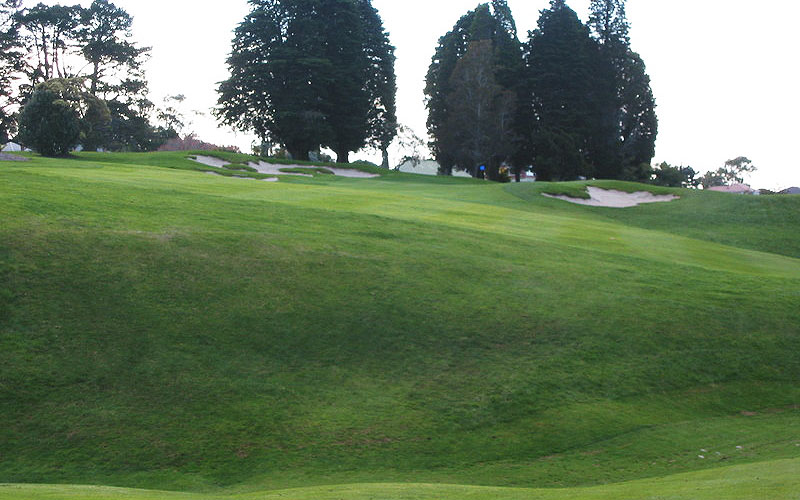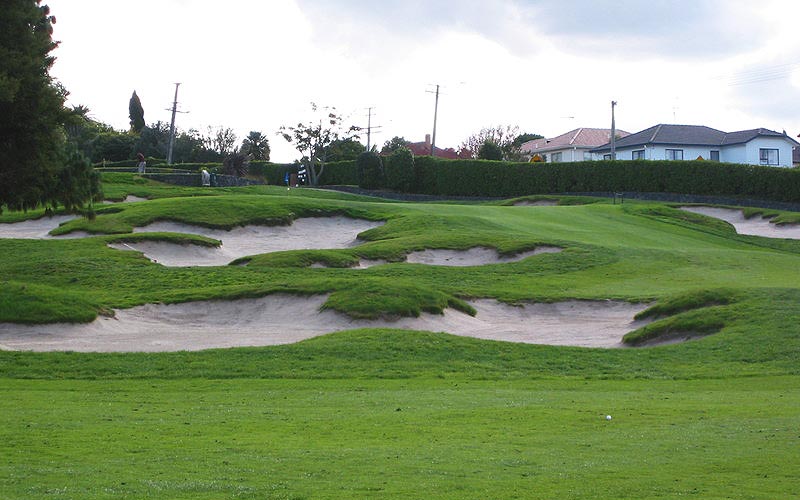Titirangi Golf Club, New Zealand
by Matthew Mollica

Alister MacKenzie was certainly one of the more widely travelled Golden Age architects. He worked in many countries, including England, Scotland, Australia, America, Argentina, and even New Zealand. MacKenzie designed Titirangi in the west of Auckland during his month-long visit to the land of the long white cloud in early 1927.
In recent years, Titirangi has slowly but surely been undergoing restoration. Today (mid-2008) only a handful of bunkers, and two greens (the 1st and 17th) are yet to undergo modification. Many bunkers have been extensively renovated and a new tee or two has been built, while the routing remains unchanged. Titirangi’s consultant course architect, New Zealander Chris Pitman has been appointed to restore much of the original character and aesthetic to the course. Not having visited Titirangi previously, I’m not able to comment on the magnitude of change at the course, or how the course appeared prior to restoration efforts. However, comparison of those holes yet to undergo work, with parts of the course where work is completed reveals significant disparity in bunker styles and to a lesser degree, differences in green contouring. The unaltered holes feature less pronounced green contours, and more simplistic bunker shapes; previously artful hazards have perhaps been blunted by the ravages of time.
From the championship tees, Titirangi measures 6030 metres, with a par of 70. Many of the holes traverse interesting, undulating ground. MacKenzie appears to have extracted all he can from Titirangi’s property, in some parts creating a tight-knit routing. As an example, the first tee, seventh green, eighth tee, eighteenth green and practice green, are all nestled comfortably within a relatively small parcel in close proximity to the clubhouse. Holes eight through fourteen make a long, steady trail to an area at the southern reaches of the property, boasting ravines and lush mangrove-type vegetation. This area makes for several thrilling shots, but more on that later.
A round at Titirangi starts simply enough, with the easiest hole on the course coming in the form of a 282 metre par 4 first. One best plays this straight hole down the right, over the brow of a small hill, past a simple solitary right side fairway trap. The green is blind from the tee, driveable in favourable conditions and relatively flat, yet bunkered strongly at its left. In the days of hickories and wound balls, the drive bunker would no doubt have asked a sterner question than it does in 2008. I suspect most golfers would clear the trap with a mid-iron today.

The opening drive at Titirangi.
I found the 312 metre par 4 second hole more interesting than the first. Fairway bunkering winding its way down the left, and a steep, grassy slope defining the right edge of the fairway, combine to progressively pinch in the tee shot landing zone the further one drives towards the green. Golfers may elect to play safely from the tee, hitting an iron or hybrid club to a wider fairway segment, or conservatively make a daring play with driver to a narrow target, providing a much shorter approach. A solitary tree stands near the second green, significantly removed from the front right fringe, and exerts a visual effect more than anything else. The second green was one of the more interestingly shaped on the course, with its front right lobe easily visualised and affording more simple approaches. The back-left portion of green is difficult to sight, even by those who have driven aggressively. This segment of the green is little more than a club deep, protected by sand at its front and left, and consequently, tougher to access.

The view from the tee on the second hole.

Closer view of the second green.
The golf suddenly gets more difficult when standing on the third tee, where a long, straight drive is demanded on the 389 metre par 4 third. This is the second toughest hole on the course, and asks for an approach which is longer than yardage suggests. Both the drive and second shot are played slightly uphill, with the approach traversing a valley and several frontal green-side bunkers. Slopes around the green are steep; balls falling short of the putting surface can funnel back down the slope dozens of metres, whilst those coming to rest beyond the back to front sloping green necessitate the most delicate of downhill chips.

The third hole, as viewed from the tee.
The first par 3 of the day comes in the form of the steeply downhill 171 metre fourth. Play is made towards a generously sized green, bunkered left and right. Each of the par 3 holes at Titirangi play to a different cardinal compass point. An even par result across the four one-shot holes is a great challenge.

The drop shot par 3 fourth hole.
The first par 5 of the day comes at the fifth hole. Measuring 485 metres, the hole dog-legs slightly to the right, turning more sharply in its final 80 metres. Bunkering on the inside of the dog-leg at the second shot landing zone partially obscures the putting surface, yet serves as a good aiming point, and area from which to play a wedge approach. The fifth hole has often been divided into two holes through the last few years – a mid-length par 4 to a temporary green, and a mid-length par 3 to the existing green. Division of one long hole into two has served the club well during times in which parts of the course have been out of play due to renovation.

The par 5 fifth hole, as viewed from the tee.
The sixth hole at Titirangi (par 4, 387 metres) is an interesting hole, providing perhaps the toughest approach on the course. The drive plays slightly downhill and to the right, from which point, the hole shifts dramatically uphill and to the left, culminating with an offset green with bunkers flanking both sides. One may elect to hit a three-wood from the tee, providing a longer approach, yet one played from relatively flat ground. Drives played further down the hole, may be played from downhill, side hill lies, significantly complicating approach play. The shot into the sixth green is quite daunting with the well bunkered green significantly uphill.

Approach to the sixth green.
The par 3 seventh (190 metres) is another stout one shot hole, played over a sizeable valley, to a generously sized and boldly contouring green. Three distinct tiers lie within the putting surface. Those golfers hitting their tee shots to the correct portion of the green are rewarded with significantly easier birdie and par putts.

The par 3 seventh green, with the Clubhouse beyond.
The eighth is a short (310 metres) par 4 playing downhill and bending slightly to the right. It is one of the easier holes on the course, despite the presence of a creek at the left edge of the fairway and green. The bold play of driver towards the green, over the trees defining the right edge of the hole, doesn’t really appear worth the risk. A hybrid or fairway wood from the tee will invariably yield a simple wedge approach to a green bunkered at its right side. The eighth putting surface tilts significantly from back to front and slightly towards the water at its left edge.

View of the approach to the eighth green.

Recently renovated greenside bunkering on the eighth hole.
The front nine at Titirangi rounds out with the fourth hardest hole on the course, a slightly uphill, slight dog-leg right par 4 of 388 metres. A little tree clearing on the right side of this hole (between this fairway and the parallel sixth) would do wonders for the appearance from the tee. A solitary bunker lies in wait at the inside of the dog-leg, while several bunkers guard the right side of the ninth green. Those missing the putting surface left contend with rough grass and mounds, as well as a green surface which tilts slightly away from them.
The tenth hole is a 352 metre par 4, playing straight away towards a recently-reconstructed green perched neatly on a distant rise. Most golfers would find their drives residing in a small valley between tee and green, providing an uphill lie and short-iron / wedge approach. Bunkering both left and right of the tenth green necessitates an accurate approach.

The tenth hole.
The eleventh hole is a 161 metre par three, named ËœRedan’. The green is perched 160 metres away slightly above the level of the tee, beyond an imposing marsh-like valley. The relatively rectangular green is angled from ten o’clock to four o’clock, and boasts a string of three bunkers at its front, aligned parallel with the axis of the green. The green surface tilts slightly to the right.

The par 3 eleventh hole.
The twelfth hole is the toughest at Titirangi, a par 4 measuring 419 metres. This hole perhaps played as a par 5 in times past? The hole bends slightly to the left around 175 metres from the tee, where a solitary bunker defines fairway movement. From this point, the hole extends in a very linear manner, to one of the deeper greens on the course. This hole serves as just one example at Titirangi, where a course of relatively modest length, can still demand a long approach shot, if par is to be attained.
The thirteenth hole is the final par 5 at Titirangi, and has no doubt changed in appearance over the years with growing vegetation. Measuring 468 metres, a blind drive is played over hedge-like plantings towards a fairway running a little more diagonally than one may imagine from the tee. Thankfully the fairway is much more receptive and a little wider than one may also assume. Having successfully found short grass with a good drive, one is confronted with the tantalising opportunity of reaching the green in two. As a visual distraction, a solitary tree stands proudly in the middle of the fairway approximately 150 metres from the centre of the thirteenth green. Golfers hitting a conservative lay-up second shot should easily steer clear of the foliage, whilst those considering a long second at the putting surface are almost certainly skilled enough to go left, right or over the tree. A pair of bunkers sits at a comfortable approach distance from the thirteenth green, demanding that those hitting a lay-up second accurately assess their yardage and the club with which they wish to approach.

The drive at the par 5 thirteenth hole.

View of the long second at the par 5 thirteenth, taken from the middle of the fairway.
The fourteenth was my favourite of the par 3 holes at Titirangi. Measuring 185 metres, it plays over another heavily vegetated valley to a generously sized green, boasting bold contours and considerable left and right green side bunkering. The tee shot is demanding yet thrilling – any shot not finding the putting surface could result in a score of considerable size. Yet even with a green hit in regulation, tee shots played to the incorrect portion of the green will see many golfers do well to secure a three-putt bogey. This putting surface, along with the seventh, boasts several pronounced shelfs and contours, not too dissimilar to the tenth green at Barnbougle Dunes.

MacKenzie’s marvellous par 3 fourteenth hole.

Unkempt natural appearing bunker edges, adjacent to the fourteenth green.
The fifteenth hole is another enjoyable challenge, aptly titled ËœTemptation’. The drive on this 368 metre par 4 is played over a ravine, to a fairway which sits diagonally (from five o’clock to eleven o’clock). Golfers confident in their driver yardage or their ability to hit a draw can appreciably shorten the approach shot with a solidly struck drive. Those hitting fades or less inclined to negotiate longer carries down the left of the hole may play safely to the right, yielding a much longer approach. Greenside bunkering both left and right sits predominantly at the front of the putting surface, ensuring that run-up approaches be played accurately. The fifteenth is an artfully constructed two-tiered green, with the lower of the two tiers sitting at the rear of the putting surface.

The fifteenth hole – note the diagonally situated ravine to be cleared with the drive.

Simple bunker appearance at the left of the fifteenth green in contrast to the recently renovated hazards.
The sixteenth hole provides yet another imposing driver challenge, with the tee nestled within a copse of trees. The hole calls for a straight drive played to the left of the fairway, owing to the slight left to right tilt of the ground on which the sixteenth hole is routed. The hole itself is relatively straight, and demands an approach played over a small grassed valley, to a green of forty yards width, yet only one club in depth. The back to front tilted green, as well as long grass and a pair of bunkers at the rear of the green, and the close proximity of out-of-bounds stakes beyond the hazards, means accurate approach shots are a must into sixteen.
The uphill 425 metre par 4 seventeenth hole provides the final strong test at Titirangi. The hole dog-legs slightly to the right, demanding a long fade drive and a long straight approach, to a somewhat flattish and sparsely bunkered green complex, which like the previously pictured greenside bunkers of the fifteenth hole, has obviously not undergone the work so many other hazards have enjoyed at Titirangi.

The drive at the penultimate hole.
The home hole is a 338 metre par 4, which plays from a tee well above the fairway, which dog-legs to the left and then winds uphill. Strong drivers may cut the corner of the dog-leg, providing short wedge approaches to the final green. Many golfers will elect to safely play away from the heavily bunkered region at the inside of the dog-leg, leaving themselves a solid short-iron approach to the green which is surrounded by bunkers. The eighteenth green is another which tilts significantly from back to front, demanding great nerve and skill whenever downhill putting is undertaken.

Bunkers on the inside of the dog-leg 18th hole, with the green just visible beyond.
The recent work at Titirangi appears to have been performed relatively well, with bunker styles appearing relatively consistent across the course. It is also reminiscent of some of MacKenzie’s hazards at other layouts where he worked at a similar time, albeit in better locales, and on more suitable soils. The par 3 holes at Titirangi all provide great enjoyment and stern tests. A great mix of short and long approaches on par 4’s are offered at Titirangi “ more than 140 metres difference is seen between the shortest and longest of the two-shot holes. Several options existed on the tee at many holes, and in keeping with MacKenzie’s frequent practice of building half-par holes, both par 5’s appeared reachable under suitable conditions, especially from regular club tees. In a similar vein, less skilled golfers may choose to tackle the longer par 4 holes at Titirangi as par 5s.
The highlights at Titirangi for me were the par 3 holes (particularly 7 and 14), the boldly contoured greens, and the demands this places on the golfer, not only in approach play, but chipping and putting. The ravines and valleys one contends with while driving on holes 2, 11, 14 and 15 in particular provided exciting golf. The ravine on 15 is quite reminiscent of the barrancas at Pasatiempo. MacKenzie did however employ the steep depressions at Santa Cruz much more artfully, and not just to influence play from the tee.
I was intrigued by MacKenzie’s employment of the solitary trees near or on playing lines at 2 and 13 respectively – certainly curiosities, assuming they are of his doing. The absence of a thrilling, genuinely driveable short par 4 was somewhat disappointing. The first green is reachable, yet it’s a simple hole, which may suffer by virtue of its position in the round. Rather than serving as a dramatic short par 4 like the tenth at Royal Melbourne’s West Course, or the third at Royal Adelaide, Titirangi’s shortest par 4 performs as a simple opener, expediting departure from the clubhouse, rather than truly inspiring and challenging. Holes eight and eighteen are the next two shortest par 4s, yet their greens provide little to no temptation to those standing on the tee with driver in hand.
Titirangi is a short course by today’s standards, yet it is fun and challenging, providing an enjoyable test, where accuracy is repeatedly demanded if one is to play to their handicap. Several long approaches to par 4 holes and the absence of a short par three ensure that full shots are repeatedly tested throughout the round. Titirangi is a golf course which not only boasts a proud heritage. It possesses several qualities which designers of today should try to build into their own future designs. Titirangi’s thrilling drives, dramatic green sites and bold green contouring are but some strengths which should inspire today’s course designers. Owing to Titirangi’s modest length, one has the chance to quickly complete 18 holes “ surely a plus in our time-poor world of today. It’s hard to see a foursome take more than four hours at this course.
While certainly not MacKenzie’s best work, Titirangi provides enjoyable golf, over a site which has been used to its fullest extent. I eagerly await a return visit, for another dose of The Good Doctor’s brand of pleasurable excitement.
The End







